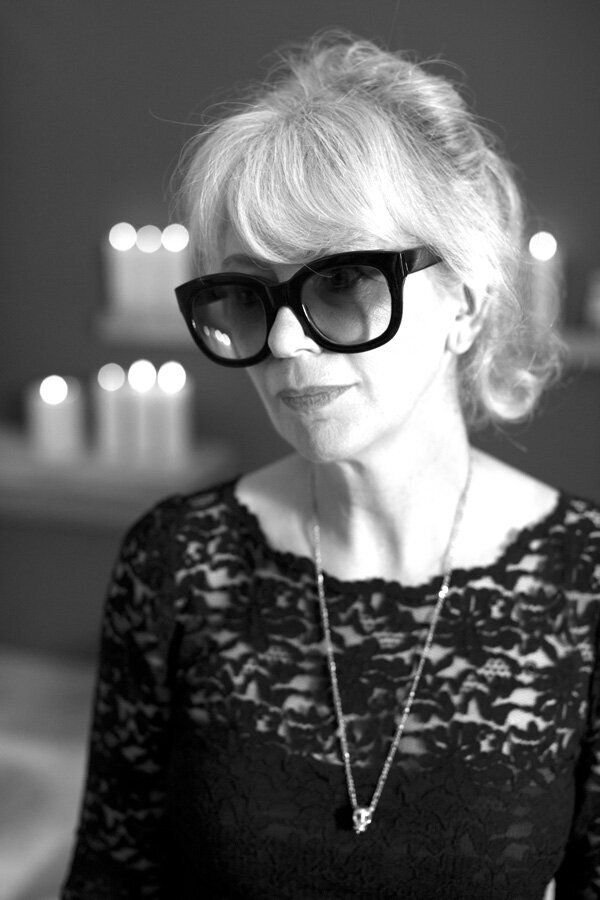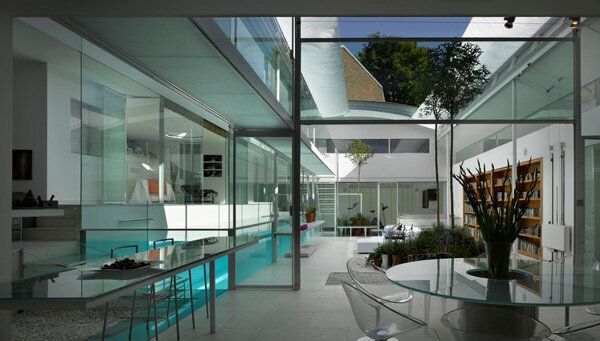Jason Holmes met up with architect and artist Heidi Locher to find out what makes the design luminary tick
This is the house that Heidi built. We're sitting in Lavender House on Gayton Road, Heidi Locher's London home, set far back from the road behind a high gate, a temple to Modernism hidden between the Victorian walls of her Hampstead neighbours.

The finest of her residential projects, the house is undoubtedly the product of a mind that thinks in clean design terms. Space is utilised, not forgotten. The walls are sheer plains of translucent colour which provide for high ceilings and broad sweeps of aired floor, the sky visible through the retractable roof where cloth sails billow. At the centre of the house, visible through glass walls, lies the swimming pool, beating like a warm blue heart.
The house took three years to build in the identifiable Paxton-Locher style. 'This house doesn't have a garden' she says, 'a proper garden that allows you to see the sky, so I'm about to put a garden in the garage area, which will move the garage forward. I'll plant trees.'
Heidi graduated as an architect from the RCA in 1982 and then worked for Terence Conran for a spell. In 1985 she established the architectural practice of Paxton Locher with her husband Richard Paxton. They went on to become pioneers of London loft-style living and undertook projects for clients including Douglas Adams and Griff Rhys Jones. Following Paxton's death in 2006, Locher founded Studio Locher, a move that has seen her spread her creative wings.
'We're absolutely hemmed in all the way round in this house. But once you're in here on Gayton Road, through a discreet entrance - which I think is very British in that there is no conspicuous wealth - the space just opens up. It's quiet, tranquil and serene. It's hard to talk about what I don't like about the house because I designed every inch of it.'
Locher has employed sufficient intellectual and design rigour. The house stands as testament to her crystalline vision. 'If you gave me your design brief, I would redesign it. But this house works for me as I conceived it: as a family house and for somewhere to work.'
Is she concerned who buys the house should she sell? 'No, not at all. I've never sold properties to people I've never liked. And anyway, I think you have to know a little about architecture to want to live in such a modern space.'
Locher's recent exhibition of projections, photographs and a short film at the Londonewcastle Project Space in Shoreditch called Hotel Kalifornia saw a coalescence of her practice's fine art and architectural disciplines, and dealt with social alienation and disengagement, what she calls the 'geography of loneliness', but her first love has always been architecture.
'I believe that your environment makes a difference to you. I've just bought two loft spaces in Camden which I'm about to knock together to create a home and studio. I'm also hoping to design and build a place in Malibu that's near the sea but up in the mountains a bit, that has a central fireplace from which everything spins.'
Does it make financial sense to work abroad? 'Abroad is not necessarily where the money is, but it's where my heart lies for designing, because the weather is better and the restrictions fewer. Compared to Britain, you can do a great deal more in California. I hope to look into that next year.'
Studio Locher has also just designed a range of couture furniture. Locher's vision and philosophy appears total, her artistry without boundaries. I tell her she possesses her own theatricality. Would she ever act? 'I would do anything that was intriguing, and intellectually and creatively satisfying. When I was young I was asked to be in movies. But as an artist and architect, I am wholly focused on design.'

In 1996, Paxton Locher won the commission for the new Soho Theatre, which was a conversion of a 1960s block on Dean Street: 'What we tried to do was make the communal space central to the building. Mary Allen, the then head of the Arts Council, was a forward-thinking woman. The restaurant and bar helped fund the development while also building the theatre's community. It was a new way of thinking. We did the same at The Jerwood Space in Southwark.'
For an artist, Locher possesses an unusually keen business sense. 'I have quite a good business head, but that's only because I am determined when trying to get things done. I try and bring all my intellect to bear. I, of course, sometimes doubt myself, but I think there must be a way, always, to think through design problems.'
Is her professional world one in which she must convey a personal strength? 'My armour is comprised of being very well organised when I am not naturally that way. My armour is quite thick. Architecture, design and art are very gentle things. It's a kind world. I've never experienced envy or competitiveness from my peers. I think that artists and architects are curious people who want to explore ideas.'
But with cranes cluttering the London skyscape, surely there's a surfeit of buildings. 'No, I think the more buildings there are in London, the better. Yes, sometimes they're not very good, and that opens up a huge question about planning and planners and how qualified they are. Are they making the right decisions? I am saddened by mediocrity and lost opportunities, because often planners will go for middle-of-the-road architects and schemes. However, I love the work of Norman Foster, Richard Rogers and Jeremy Dixon. The Royal Opera House refurbishment in particular is also brilliant. I also think David Chipperfield is a wonderful architect.
'I love the Shard, but I wish it were taller,' she laughs. 'I wish the Gherkin were taller and bigger, better and more elegant. Buildings should soar, and planners should not get scared. If there's a criticism of our culture, it is that we like what we know and are bad at being experimental. There should always be experimentation in architecture, so the more buildings, the better.'
Does she worry about who's in charge in Westminster? 'I do. I worry about art becoming of little importance in the education system. I want more appreciation of philosophy and culture. In a recession, the arts come alive. The underground movements throw up interesting things.'
The fission of Locher's ideas is palpable, her creative impulsion a constant. 'I get up every day and go to my studio. I have anything between two and four projects on the go at any one time. I have three or four people in my team, but then we bring in more depending on what we're doing. Next year, Studio Locher will be launching the couture furniture, so things will step up a pace and there will be a bigger team. It's great to collaborate.'
And settling into her cushions, she tells me that she was once the house model for Christian Dior in her youth. 'I love London and England. I love my mates. I love fashion and the way it mimics fine art. It makes me smile. Architecture is, after all, the clothes that we live in.'
And the key to life? I ask, as I eye the pool and wish I'd brought my trunks.
'Enthusiasm,' comes the reply. Enthusiasm. That Heidi has in abundance.
© Jason Holmes 2012 / jantholmes@yahoo.co.uk / @JasonAHolmes
Portrait photograph by Ryan Koopmans; Lavender House photograph courtesy of Studio Locher
Visit www.studiolocher.com for further information.
